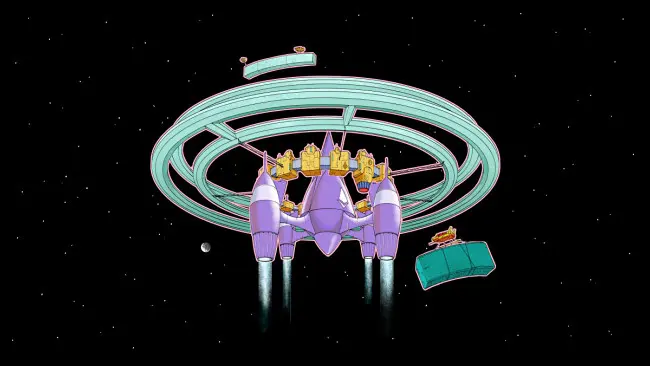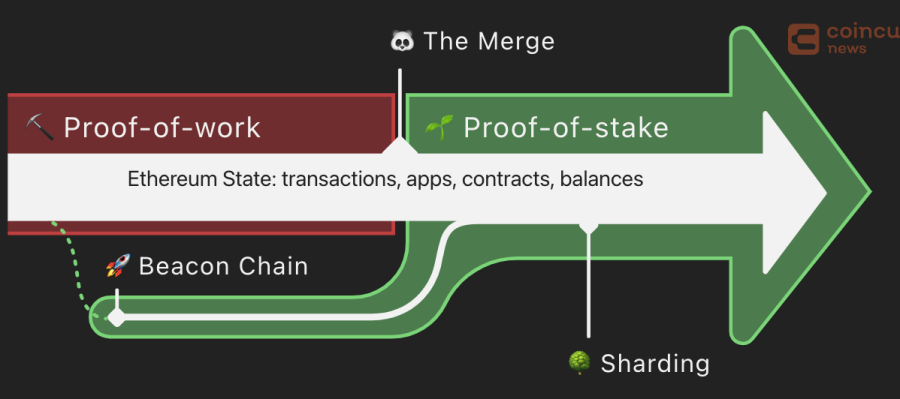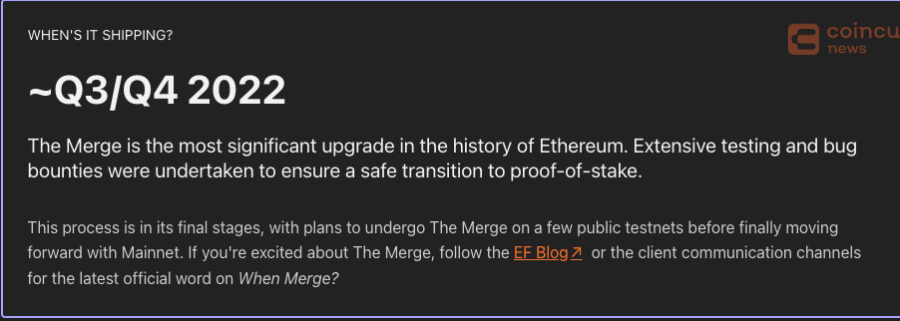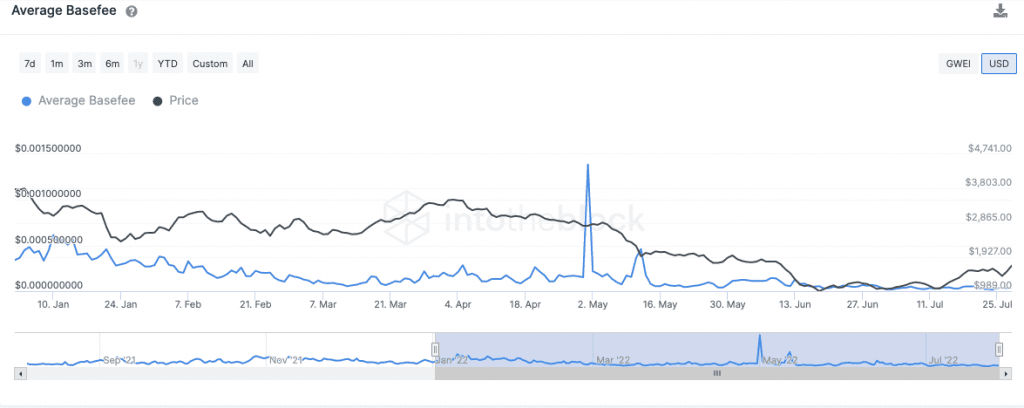The Merge is the most critical upgrade of Ethereum in 2022. This is the event that the Ethereum network moves entirely to the Proof of Stake POS consensus mechanism.
However, there has been much confusion surrounding Ethereum’s The Merge event: Where did The Merge come from, and what will happen after The Merge?
In this article, Coincu will provide everyone with a before-after-and-after background of The Merge, in addition to the major impacts of The Merge on Ethereum and its ecosystem.

What is Ethereum Merge?
Ethereum Merge is a significant upgrade event of the Ethereum network where the blockchain will be upgraded to use a new consensus mechanism. After the upgrade, the Ethereum network officially switched from Proof-of-Work (PoW) to the Proof-of-Stake (PoS) consensus mechanism. A fascinating step in realizing the Ethereum vision – more scalability, security, and sustainability.
With Ethereum upgrading to the PoS version, ETH holders can stake in validators to participate in the validation of new blocks and receive a reward of ETH.

According to the project’s announcement, the Merge event will take place in Q3 or Q4 this year.

Why is Ethereum Merge?
It is like Bitcoin; it uses the proof-of-work (PoW) consensus mechanism, which forces users to resolve challenging mathematical puzzles to validate transactions and protect the network.
This approach works, although it isn’t very effective. To have a chance at mining the transaction blocks and obtaining rewards, people who find solutions to these issues, known as miners, must use a significant amount of energy and resources.
Why does this matter? Ethereum’s goal of decentralization is defeated if only a select few people can utilize it.
Companies with enormous computing power can take control of over half of the validator nodes, leading to much higher security threats to Ethereum. A decentralized blockchain can’t afford to have central points of failure. The Ethereum founders realized this and included a transition to another consensus mechanism called proof-of-stake (PoS).
The difference between Ethereum and Ethereum Merge
The most significant difference between Ethereum and Ethereum Merge involves using Proof of Stake (PoS), Sharding, and Beacon chain.
Beacon chain
The core of Ethereum 2.0 is Beacon Chain. This is a separate blockchain launched on 12/2020, operating in the form of a completely independent POS consensus layer and runs in parallel with Ethereum Mainnet. Beacon Blockchain was released to prepare for the Ethereum Merge event.
Proof of Stake
Proof of Stake (POS) is a consensus mechanism that will replace the current mechanism of POW (Proof of Work).
You can understand that the value and system of Ethereum will no longer depend on mines and miners because the system will be stronger and no longer affected or dominated by miners.
Sharding
Merge’s success will be the night step for Ethereum to deploy Sharding. Sharding is a method of replicating transactions on the chain. The method separates an extensive database into small databases for processing.
Sharding is one of the most complex approaches to expanding the scale because design and implementation require a lot of effort. However, if done successfully, it can help the Ethereum network process transactions up to 100,000 TPS while ensuring security and decentralization.
The effects of The Merge on the Ethereum network.
PoS consensus will reduce 99.95% of the energy needed to operate Ethereum
The existing Ethereum mainnet uses the Proof of Work (PoW) consensus to authenticate the conformity of transactions taking place in the network. According to estimates published on Ethereum Foundation Blog, Ethereum Mainnet’s energy consumption is equivalent to an average-scale country.
But after The Merge, Ethereum’s power consumption will significantly decrease. After The Merge, the power consumption used to operate the Ethereum Network will decrease by 99.95%, equivalent to 2000 times.
The image below shows an interesting comparison of Ethereum’s energy consumption after The Merge.
No more pressure from the miners
In the Pow blockchain, like Ethereum Pow, ETH exploitation is extremely expensive because of the cost of hardware and electricity. Always exist a voltage from the miner side to cover related costs. Sometimes the miners exploit ETH simply because they are investing in hardware and electricity, not for ETH investment.
In contrast to the Ethereum POS, ETH Staker does not need to spend a lot of deployment; they are only forced to Staking ETH. Therefore, on this basis, ETH Staker has no pressure to sell ETH to cover high operating costs like ETH Miner on Ethereum Pow.
The number of Ethereum released may decrease sharply.
Every day, the number of ETH released to the market will come from Mining Reward and Staking Reward.
Every day there will be about 14,500 – $ 15,000 ETH released, of which 90% comes from Mining Reward.
Starting from August 5, 2021, EIP-1559 was adopted and applied to Ethereum Network, where a Base Fee mechanism was adopted. Base Fee is the minimum fee quoted by the protocol to bring transactions into a block on Ethereum. That is the minimum level of gas fee for transactions to be carried out.

Reward users pay an additional priority fee for priority transactions. According to Intotheblock, this fee accounts for 10% -15% of the Total Fee (this is also the extra income of Minner)

After the Merge event, there will be no longer be block rewards created on Ethereum PoS. In other words, the new ETH supply will immediately decrease from 14,500 – 14,000 ETH/day to 1,500 – 1,600 ETH/day. At that time, the total number of new ETHs on the market will be calculated by: New ETH Issued on Ethereum Pos Chain – Total Fee Burn.
Based on the data above, we can conclude that the number of Ethereum released daily can decrease sharply. Even the supply may be deflation.
The effects of The Merge on the cryptocurrency market
Impact on layer 1
The battle between Layer 1 platforms will be pretty harsh because the upgrade of Ethereum is a significant step. Considered the most stable layer, with high security and decentralization. Although gas & speed costs are still high, developers may still choose Ethereum as the platform for the project to build their project.
Therefore, when The Merge event took place successfully, the cash flow would be pulled back to Ethereum inevitable. This requires Layer1 platforms to have improvements to compete.
Impact on layer 2
For Layer 2 platforms, The Merge will be a big purge, especially for layers two platforms focusing on solving the speed and fee of the Ethereum network because the Merge takes place when The Merge Success, speed, expansion, and cost of Ethereum will be improved.

However, the Layer 2 platforms that keep Ethereum’s security will still have great potential for development and long-term growth.
Impact on the Cryptocurrency market
In terms of the entire crypto market, if The Merge is successful and the Ethereum 2.0 network comes into stable operation, then in the long term, this will promote significant investment funds and technology corporations involved in The Crypto market, which will help the market grow sustainably with the sources of money and customer files from the traditional public vocational market will pour in.
Verdict
Above is all information about Ethereum Merge and its impact.
I will summarize some of the main points for you to grasp:
- Ethereum Pow will officially turn into Ethereum PoS.
- The energy used to operate Ethereum decreased by 99.95%.
- The supply of Ethereum becomes lower, or there is low inflation.
- The fierce competition between layers 1 will take place.
- Large cash flow from external technology companies may pour into the market.
If you have any questions, comments, suggestions, or ideas about the project, please email ventures@coincu.com.
DISCLAIMER: The Information on this website is provided as general market commentary and does not constitute investment advice. We encourage you to do your own research before investing.
Ken. N
Coincu Ventures























